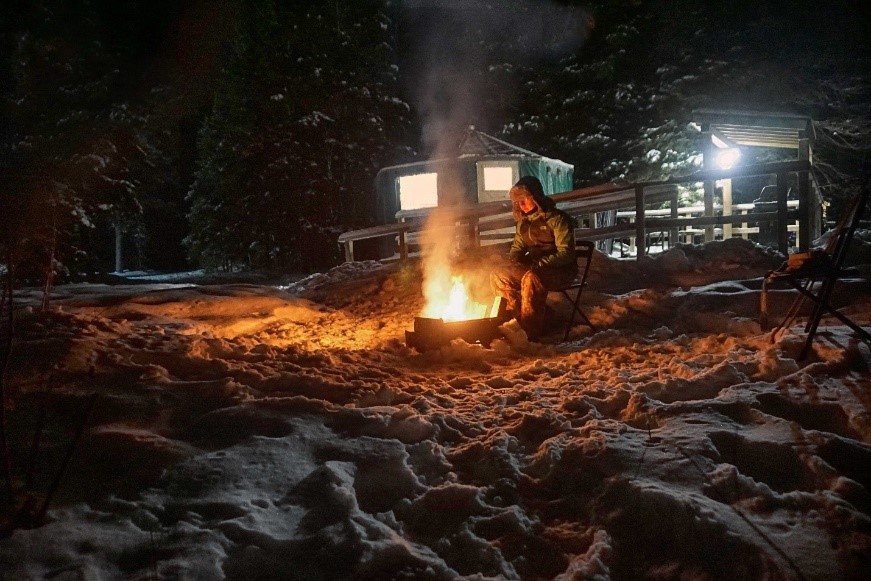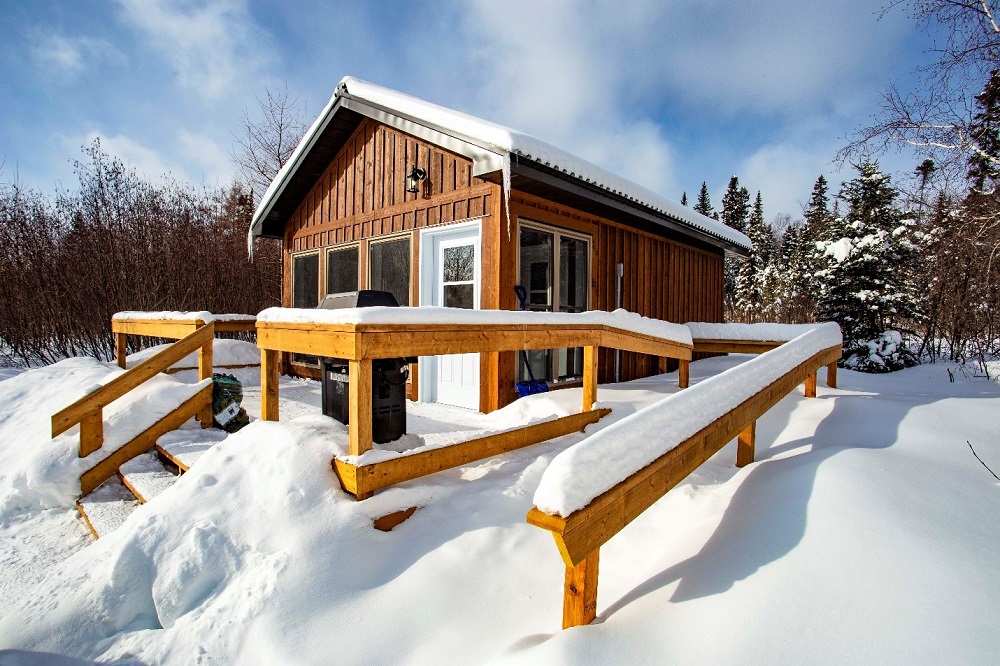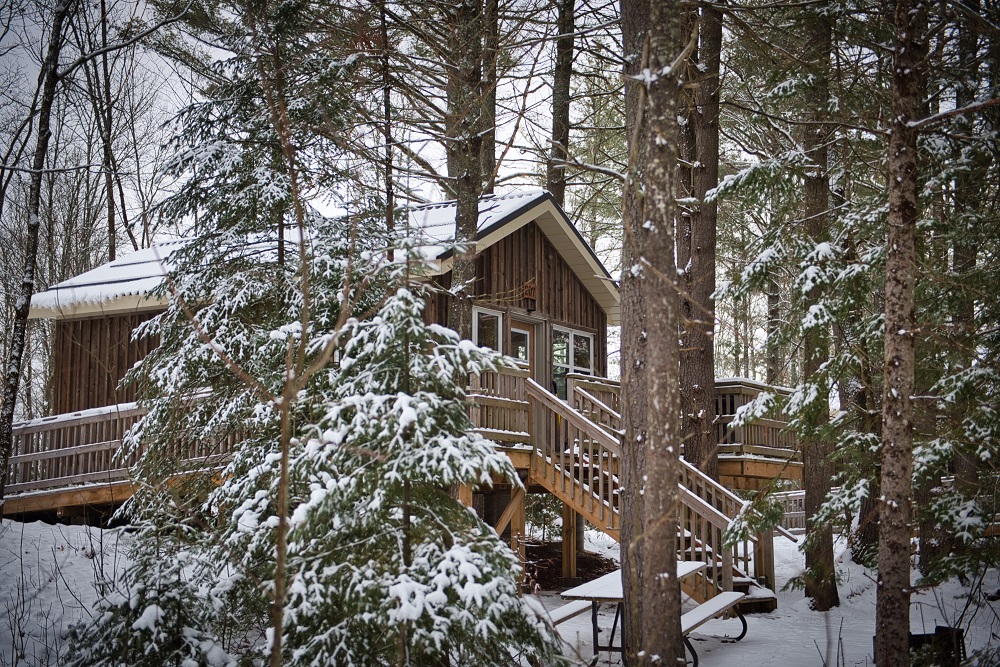So you still haven’t had enough of the outdoors, even though winter has arrived?
Neither have we!
Day-tripping to your favourite park is a great way to get outside, but maybe you’ve decided to try an overnight stay this winter. Great choice!
Yurts and cabins are a popular way to experience winter at Ontario Parks. Stay warm and cozy while you enjoy all a park has to offer in the winter, from watching early morning sunlight reach across fresh snow, to skiing or snowshoeing through the forest as the snowflakes drift down.
Here’s everything you need to know for your winter adventure:
Parks in winter
Your yurt or cabin stay starts by making a reservation, up to five months in advance of your arrival.
Once you’ve booked your accommodation, it’s time to plan the trip itself.
If you haven’t checked out the winter information on the park you’re visiting, our Winter in Ontario Parks webpage is a great place to start.
The page lists all of the parks that are open, and what type of winter camping they provide.

Many parks provide heated roofed accommodations — yurts, cabins, or both!
Don’t forget to check out the webpage of the park you’ll be staying in.
The “Overnight” tab tells you all about the options for staying in that park overnight in the winter.
The “Activities” tab tells you what there is to do, from winter trails to skating to ice fishing, depending on what the park offers.
So what’s a yurt?
Ontario Parks’ yurts give visitors the chance to explore nature AND have a warm and cozy place to come back to and spend the night.
A yurt is a soft-sided tent-like structure and ours look like this:

They are heated, have bunk beds that sleep five or six (check with your park), a table with chairs, an outdoor wooden deck with a barbecue for cooking, and a picnic table.
Yurts have ceiling lighting and hydro, so you can plug in batteries and phones.

Yurts don’t have running water or a washroom inside, though facilities are often close by.
Outside, there is a campfire pit for outdoor gatherings.
Some yurts are on plowed parks roads, and you can drive to them, even in winter.

Others, like the yurts at Windy Lake Provincial Park, are “trailside,” meaning you pull your gear to the yurt in a toboggan provided by the park. In these, you’ll find cross-country ski trails and snowshoe trails at your door!
What’s a camp cabin?
A camp cabin is a small, one-room cabin, often with one queen bed and bunk beds that can sleep five or six, a table and chairs, and a small kitchenette with a counter, microwave, and mini fridge.

It has a small, screened front porch that leads out onto a large deck, with seating and a barbecue. Camp cabins don’t have running water or a washroom inside.
Cabins are heated, have lights and power, and are generally road-accessible.

Always check a park’s webpage, the roofed accommodation page, and the reservation website for descriptions of the cabin you want to reserve for more details.
What to bring
Most camp cabins and yurts provide the basic amenities already described.

What you’ll need is your personal gear, including:
Clothing
Be ready for the cold. Layers are best:
- wicking base layer – tops and long underwear
- breathable windproof outer layers – hooded jacket and snow pants
- warm winter boots (not running shoes!)
- toque and gloves
Bedding
Bring along sheets and warm blankets or a comforter, or you can go with warm sleeping bags.

Don’t forget your pillow!
Gear
- headlamp or flashlight (and spare batteries!) – a must when heading to the privy in the middle of the night
- lantern – handy for lighting the picnic table or barbecue area
- clothes line – for hanging up wet clothes to dry
- hiking poles – a nice extra when snowshoeing
- hand warmers – pop them in you mitts to stay warm! Can be purchased at most outdoors stores
- if you have snowshoes, cross-country skis, etc., bring them along! Rentals also may be available at the park or a local outfitter
Food
Bring enough food for all your meals and snacks. The extra effort to move through snow, combined with colder temperatures, will make you hungry more often. Healthy snacks between meals will be key.

Make meals beforehand and reheat them when it’s dinnertime. Hot beverages like coffee and hot chocolate are great options to keep you warm and toasty all day!
Cooking
Other than using the microwave, boiling a kettle, or making coffee, cooking is not permitted inside yurts and camp cabins.
Plan your meals for the barbecue provided on the deck outside. Barbecues have side elements for pots and pans, or you can bring an outdoor camp stove to cook outside on the picnic table.

While some park cottages provide kitchen utensils, yurts and most camp cabins do not, so you will need to bring:
- pots
- pans
- dishes
- cutlery
- dish towels
- a wash basin
- dish soap
- tin foil
- anything else you need for meal preparation and tidying up
Water
Parks shut down the water taps found throughout campgrounds for the winter. Generally, it’s a good idea to bring a few large jugs of water along with you for cooking, washing, and drinking.
Dogs
Dogs are now permitted in select roofed accommodations for a fee of $40 per stay.

Dog owners are responsible for any damages caused by their pet. Only two dogs (regardless of size) are permitted per roofed accommodation.
Just like in summer, pets need to be on a 2 m / 6″ leash (not a reel).
Learn more about dogs in roofed accommodations.
Things to know:
Hydrate
It’s important to drink lots of water if you are being active outside.
Cross-country skiing, snowshoeing, and other activities out in the winter air can dehydrate you faster than in summer.

Think about bringing along an insulated drink container. They stop liquids from cooling off fast outside in the cold, when you’re sitting around the campfire, having a coffee in the morning, or on an all-day ski or snowshoe.
Washrooms
The type of washroom facilities vary from park to park in the winter.
Some parks have winterized comfort stations, while others have heated privies and no running water. Check the park webpage to see what’s available.
Weather
Check the weather and road conditions before you leave home.
Winter tires are the best for driving the country roads many of our parks are located on, but either way, drive carefully!
Cell phone coverage
This varies greatly from park to park due to location. Both remoteness and landscape (hills) can limit signal.
Check cell coverage with your provider before you go.
Things to do:
Outdoor activities
Parks offer plenty of activities to keep you busy, including cross-country skiing, snowshoeing, skating, ice fishing, and more.
Check the park’s webpage before you go for more information on what activities are available.

If you’re going for a winter walk, remember hiking trails are best traveled in snowshoes. Make sure you share the trail, and remember that groomed and track-set cross-country ski trails are for skiing only.
Or, bundle up and enjoy a winter campfire! Parks sell firewood, kindling, and fire starters, but don’t forget your matches!
Indoor activities
It gets dark early in the winter, especially the further north the park is.

This is great for early campfires and star-watching, as you don’t have to wait all evening for it to get dark.
This also means you may end up in your yurt/cabin early looking for things to do. Bring games and books to keep yourselves occupied.
Make some winter memories
Visitors who stay in a yurt or cabin in the winter have had great experiences.

If you come prepared and know what to expect, you’ll have a great trip, too!

